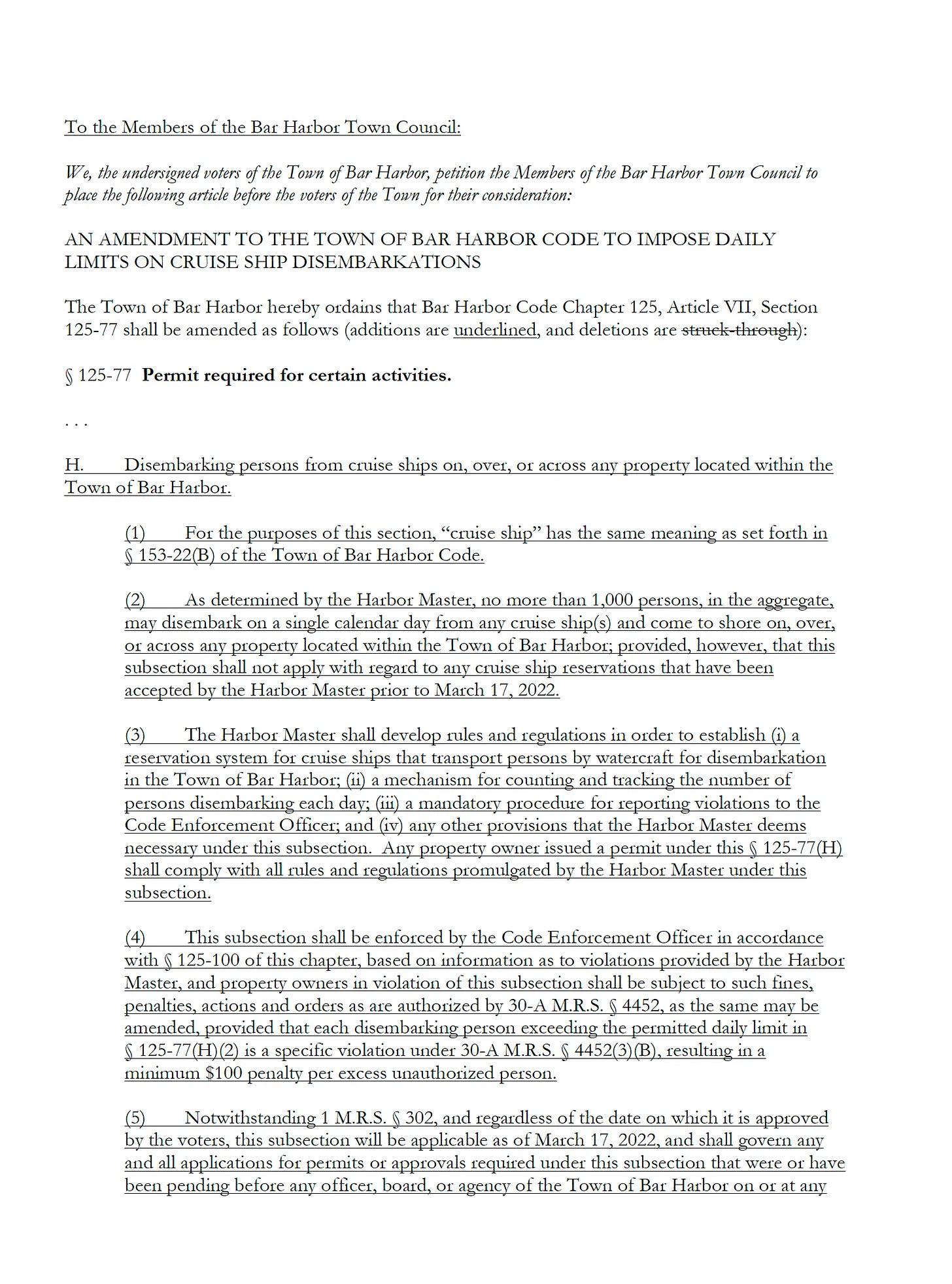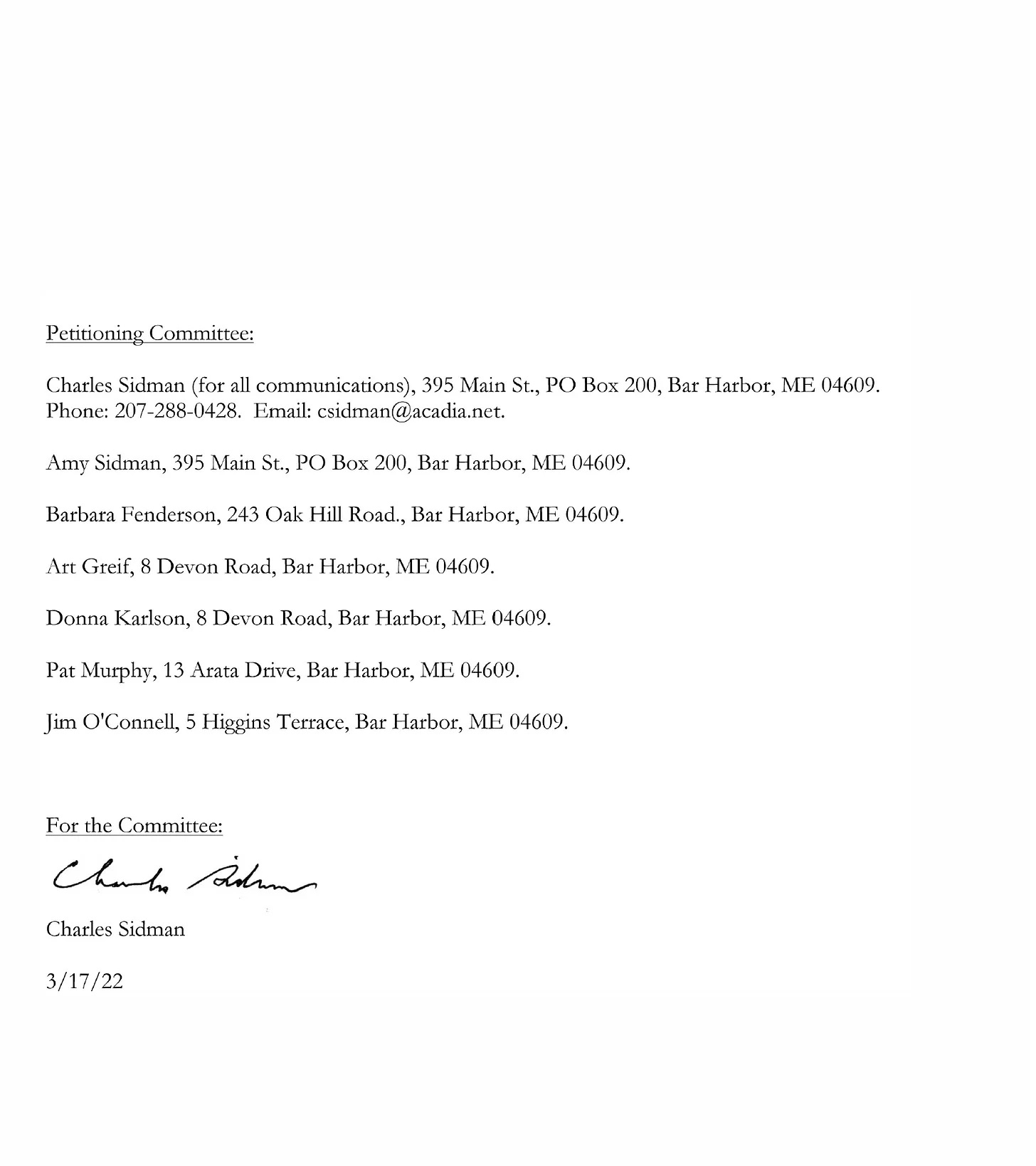The town’s restrictions on cruise ship visits has passed the council; residents will determine in November if they want to create more stringent daily passenger limits

BAR HARBOR—Bar Harbor residents have a lot of opportunities to learn more about two different cruise ship plans. The Bar Harbor Town Council voted this week to have a question and answer session during its regular council meeting October 3, beginning at 6:30 p.m. The town manager will also host a discussion about the recently approved cruise ship management plan next Wednesday, September 28, at 4 p.m. at the Jesup Library.
The town’s restrictions on cruise ship visits passed the council on Tuesday; now, residents will determine in November if they also want to create daily passenger limits.
A 2021 survey of residents found 55% of those who responded thought cruise ships negatively impacted the town. In 2019 before the COVID-19 pandemic, there were about 170 visits and an estimated 270,000 passengers who disembarked during the multi-month season. In 2021, Acadia National Park had 4 million visits though cruise ships were not allowed that year.
The recently approved town plan would ban cruise ship visits in April and November as well as have a cap of 3,800 in September and October. The current daily cap is 5,500 for those months. The new plan would allow no more than three cruise ships each day. During July and August the monthly limit would be 40,000. That limit would be 65,000 in September and October. The limit in May and June would be 30,000.
Citizen’s Petition Organizer Sponsored Event at YWCA
Charles Sidman, the main organizer of the citizen’s petition to cap daily cruise ship disembarkations in Bar Harbor to 1,000 a day has already organized a question and answer period at the MDI YWCA that occurred Wednesday night, September 21. About 35 attended the event in the YWCA’s main meeting room. The event was moderated by the Mount Desert Islander’s managing editor Faith DeAmbrose.
This citizens’ petition creates a daily limit on cruise ship disembarkations into Bar Harbor to 1,000 and a fining system for any passengers over that number. If passed, the petition would be part of the town’s land use ordinance, often referred to as its LUO.
Sidman said that his purpose was to have a conversation rather than present a point of view. Most of the questions from the primarily supportive group were about the difference between the town’s plan (which focuses on lower berth capacity which is the standard double occupancy numbers of a room within the ship) and the petition, which focuses on daily disembarkations; legalities around the initiative and its placement in the town’s land use ordinance, which several members from the town’s planning board and warrant committee had issues with; the technicalities of the process of fining and counting passengers; and if there is any burden to the town to administer the petition and its requirement of the daily counting of passengers leaving the boats and tendering to Bar Harbor.
Currently, cruise ships only tender to Ocean Properties’ property, which is more sheltered than the town-owned property. In 2009 a split Bar Harbor Town Council voted to not allow normal cruise ship tenders at the town’s pier. That tendering initially stopped in 2002 due to federal port security laws.
Several in attendance did not have questions, but instead espoused their support for the petition. Many of those who supported the petition said during the meeting that pollution, congestion on streets, and the desire for the citizenry to control the cruise ship visitation were factors in their support.
In 2019, Sidman sponsored another citizens’ petition which passed (493-384). That petition restricted piers to under 300 feet and also did not allow cruise ships that carried more than 500 passengers to tie up at piers. At the time, Sidman told the Mount Desert Islander that it “puts a marker in the ground. It says that the citizens do not want large cruise ships berthing in our town.” In that same article, he said that they didn’t want to get rid of cruise ships entirely and that they could still tender in.
Lower-Berth Capacity Discussion
Currently, the town does not count specific disembarkations and the new town plan does not either. Instead, when allowing cruise ships to visit, the harbormaster focuses on lower berth capacity.
Council Chair Valerie Peacock was in attendance at the Wednesday meeting and said that lower berth capacity is basically the number of beds on ships. The harbormaster takes those bookings on a first-come and first-served basis. On the day of the meeting, there were two cruise ships that disembarked to Bar Harbor. One had a 500 lower berth capacity and the other had 3,000.
“There would never be that many more passengers coming aboard,” she said. The “Economic Impact of Cruise Ship Passengers Visiting Bar Harbor” (2016) and the “Survey of Maine Cruise Visitors to Maine” have that disembarkation rate at 85%. Those numbers do not consider ships canceling or ships not fully booked.
A 2017 survey from the data collected by the harbormaster showed that 59% of ships in 2017 were not fully booked. Another study from 2019 showed that ships that year were 94% occupied.
Sidman and an attendee said that the lower berth capacity is a theoretical number and not the same as the number of people stepping ashore, which could include crew and also others in pull-out beds in the rooms.
Memorandum of Agreements
At the meeting, Peacock also answered questions about how the town’s memorandum of agreement works. The town’s cruise ship management plan that a split council approved at its Tuesday meeting creates agreements between the town and the cruise ship lines to not go beyond town-created limits each month. Those limits are lower than the current numbers, but not as low as 1,000 per day and don’t require counting.
Peacock as well as Councilor Jill Goldthwait were part of a team that negotiated those terms with the cruise ship industry. Peacock also said that any town resident could contact her with questions or to get together to talk about the petition and the town’s plan.
Counting the Disembarkations
One Town Hill resident said that having the town create a counting mechanism if the citizen’s petition passed was not a “big deal” and could be done by using a mechanism as simple as a subway turnstile. The daily counting of disembarkations has been a subject of worry for many who do not support the citizen’s petition.
Sidman said that if passed, “We would be innovators in controlling the industry this way.”
Land Use Ordinance Placement
During the Wednesday night discussion, one Bar Harbor resident said she couldn’t understand how the Planning Board could object to the placement of the petition in the land use ordinance. The board did, however, discuss their objections to that placement at the meeting. During committee and board discussions, several board members, committee members, and town officials mentioned that they had difficulties with the petition’s placement in the town’s land use ordinance because it places the burden of the changes on the code enforcement officer to enforce; that it adds the harbormaster into the land use ordinance, which has not been done before and would require other modifications to the land use ordinance; and that the land use ordinance doesn’t offer the same flexibility and quickness for change as a memorandum of agreement or as an ordinance outside of the land use ordinance. Planning Board member Ruth Eveland stressed during a Planning Board meeting earlier this month that the difficulties on the staff if the petition passes would be overwhelming and not able to be implemented.
During the conversation about the petition’s placement in the land use ordinance, it was suggested that the Bar Harbor Planning Director Michele Gagnon doesn’t want anything added to that ordinance because it’s already unwieldy. Sidman said that this would not be a problem, that the land use ordinance can be changed after they determine whether or not a 1,000-passenger cap a day is not enough or too much.
Supporters also said that the petition would help by keeping the council and staff from negotiating MOAs, that the climate would be better, and there would be less congestion in the street. When asked about concerns that the petition if passed could inspire lawsuits, Sidman said that lawsuits would not be an issue.
WANT TO LEARN MORE?
The Citizen Initiative itself is below.
https://www.statista.com/statistics/270649/lower-berths-of-the-north-american-cruise-industry/
Town water quality studies from 2004-2018 http://www.barharbormaine.gov/387/Water-Quality-Studies
Cruise Ship Tourism and Traffic Congestion Report (2019)
Bar Harbor Town Council Signs Agreement Limiting Cruise Ship Visits



